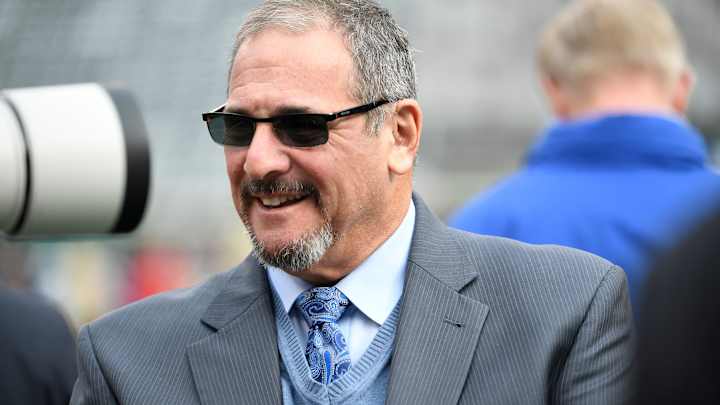How the New York Giants Made the Salary Cap Work in Their Favor

The annual NFL salary cap hasn’t always been so kind to some teams, but at the end of the day, the smart ones figure out how to massage the cap and keep on "printing money" for new free-agent acquisitions.
That is what the New York Giants, typically a team that, when it's had an abundance of cap space, has spent it and when it hasn't, it's held back, did this off-season.
Before the current league-wide salary cap of $182.5 million was announced at the end of January, the Giants were projected to be in the red in terms of team cap space by $ 3.373 million.
That wasn't going to cut it for a team with its franchise quarterback and franchise running back still on their respective rookie deals for at least another year and who had several needs to address.
So the Giants, in perhaps one of their most aggressive and bold off-seasons so far, made it all come together, leaving no stone unturned to make sure that their cap didn't hamstring them.
Here is a look at some of what they did.
Contract Cuts and Reductions
The first order of business for any NFL team is to cut the dead weight of those contracts burdening the team’s cap held by players who, in their opinion, we're no longer delivering a fair return on investment.
The Giants did just that in cutting receiver Golden Tate, inside linebacker David Mayo, receiver Cody Core, and guard Kevin Zeitler. Those roster moves freed $11.647 million in cap space while dumping just $7.205 million into the dead money ledger.
That was a start. Add the pay reductions for those still-serviceable players who don't have a long-term future with the team, and there was more cap room to be had.
The two most significant being those by tight end Levine Toilolo, whose salary cut yielded a $1.35 million savings, and offensive tackle Nate Solder, who saved the team $6.5 million this year.
Toilolo is a part-time player in the offense and is someone who, if the Giants land Florida tight end Kyle Pitts, could even land on the bubble. Solder, meanwhile, once a starting offensive tackle, but times have changed, and the Giants are committed to getting younger on that unit.
With Zeitler being sent packing, the Giants' brass felt that Solder had some value as a backup swing tackle. (And in an underrated cost-saving move, the team likely didn't want to have to spend additional money for another swing tackle while Solder's $6.5 million post-June 1 dead money cap hit sat on their books.)
So the team saved $7.85 million from cutting Solder's and Toilolo's contracts down to more reasonable numbers. Add to that what they saved by lopping off the contracts mentioned above from the books, and the Giants scraped together about $19.497 million—roughly what they needed for the franchise tag for defensive lineman Leonard Williams.
Speaking of Williams, that the Giants were able to get him signed to a new long-term deal with a first-year cap number of $11 million ($8+ million savings from the franchise tag) was vital in allowing the Giants to get some of these other deals done.
Veteran Salary Benefit (VSB) Deals
Veteran Salary Benefit (VSB) deals allow for backup and role players who otherwise don't qualify for big money to be able to gain jobs while not choking up their team’s salary cap space.
To qualify for a VSB, which counts for up to $987,500 against the cap (same base salary as a player with two years of accrued experience), a player must sign a one-year deal that doesn’t include more than $337,500 in bonuses. Thus for each qualifying VSB, teams recognize a $140,000 savings (not much, but every little bit helps).
From a team perspective, it allows them to add depth at positions without taking a significant hit. Even better, if the player who receives one of these deals doesn’t make the roster, he can be cut, and the dead money charge is minimal.
That’s the kind of deal the Giants gave long snapper Casey Kreiter and outside linebacker Ryan Anderson.
Where a VSB pays off is with older players. The more years of accrued experience a player has the higher his minimum base salary. For example, a player with 10+ years of experience is entitled to a base salary of $1.075 million. If he gets a VSB, only $850K 9minimum base for a player with two years accrued experience) plus up to $335K in bonuses count against the cap.
That might not sound like much, but if a team has several players on a VSB, the savings do add up.
Recognizing Player Value
For the most part, the Giants finally showed more constraint in not overspending on fringe players who may or may not be on the roster come opening day.
Let’s start with the decisions on their restricted free agents. The lowest RFA tender (right of first refusal) went for $2.133 million. The Giants, whose RFAs included receiver C.J. Board, inside linebacker Devante Downs, and cornerback Ryan Lewis, didn’t tender any of those three players. Instead, they managed to re-sign Downs and Board for deals amounting to nearly half of the right of first refusal tender.
Board, for example, for a 1-year deal worth $1.02 million with just $50,000 guaranteed. If he doesn’t make the final roster, the Giants will save $970,000 and be charged just $50,000 on their dead money ledger.
And Downs, re-signed by the Giants this week, is believed to have received a similar deal that shouldn’t cost the Giants much more than what they paid Board.
Then there is the guaranteed money given to role players like offensive lineman Jonotthan Harrison, running back Devonte Booker, receiver John Ross, quarterback Mike Glennon and tight end Kyle Rudolph.
The guaranteed money percentage in each of those deals ranges from a low of 25% (Harrison) to a high of 40% (Ross), with the average coming in at 35.7%.
By keeping the guaranteed money low (it should be noted that most of these deals have performance incentives), the Giants could remain competitive with their offers and not spend out of control.
Along that vein, the contract given to UFA defensive tackle Austin Johnson (1-year, $3 million (guaranteed), and up to $3.5 million with playtime incentives) can also fit into that category. The Giants likely project Johnson (likely along with B.J. Hill) to pick up Dalvin Tomlinson’s snaps.
If Hill and Johnson can give the Giants the same kind of snaps Tomlinson gave them, then that will ease the sting of having lost Tomlinson to the Vikings on a two-year (with two years voiding) deal worth $21 million.
There's a caveat here, though. The Giants, on their three big-ticket signings from other teams--receiver Kenny Golladay, tight end Kyle Rudolph, and cornerback Adoree' Jackson--are rolling the dice on players who are coming off an injury from the prior year.
That in itself is a departure from organizational practices, but it also underscores the heightened sense of urgency inside 1925 Giants Drive to win now.
Contract Restructures
A restructure differs from a pay cut because a portion of the base salary is moved from the current year to future years, whereas a pay cut means money is taken away and may or may not offer a chance for said money to be earned back.
But when general manager Dave Gettleman initially poo-pooed the notion of "kicking the can down the road," he was likely referring to restructuring contracts of players whose time with the club might not be as long-term as it once was.
Zeitler was a perfect example of this. Although he still had plenty of football left in him, the Giants committed to go all-in on a young offensive line. Rather than restructure and extend Zeitler, the team cut bait.
This was not the case with cornerback James Bradberry and inside linebacker Blake Martinez, who are about to enter Year 2 of their respective contracts.
The Giants freed up roughly $7.5 million on this year’s cap by converting part of each man's base salary into a signing bonus that prorates over the remaining life of each contract.
With that space, the Giants, according to Over the Cap's March 25 cap space table, now have $6,474,357 in cap space, a figure that doesn’t yet Devante Downs, signed yesterday (and who doesn't figure to count for much against the cap).
Restructures are done as needed. If the Giants have to restructure more deals, some potential candidates include punter Riley Dixon, whose cap hit can be lowered by about a million. Receiver Sterling Shepard is thought to be another potential target for a restructure though given that he’s missed games in each of the last two seasons, he might not be at the top of the list.
What the Giants can also do—and quite honestly, it’s a surprise they haven’t yet—is to sign safety Jabrill Peppers, who right now counts for $6.77 million against the cap to a contract extension to get his number lowered.
Creative Accounting
When it came to the contracts for Kenny Golladay and Adoree' Jackson, the Giants used a voidable year.
The CBA allows teams to spread a signing bonus over a contract's life up to five years. For example, Chiefs quarterback Patrick Mahomes, who signed a 10-year deal with over $34 million to sign, can only have that signing bonus spread out over five years of the contract.
The Giants, who didn't give any contracts longer than four years--a lesson they learned from the disastrous 2016 spending spree--put one voidable year in the Golladay and Jackson contracts.
The mechanism (which, quite honestly, I was surprised the Giants didn't use for Leonard Williams’ contract) helps lessen the signing bonus's impact.
Another benefit of using voidable years is it helps one get the first year of a contract as low as possible. If Golladay didn't have the voidable year, his per-year signing proration would have been $4.25 million instead of $3.4 million.
A goal of any team that signs multiple players to big-money deals is not to let the first-year totals of those deals get out of hand.
The Giants did a great job with this. Except for Leonard Williams, none of the big-money free-agent signings rank in the Giants' Top-10 for this year.
Using adjusted total cap figure from Spotrac ($191,664,992), the first year of the new contracts for Williams, Jackson, Golladay, and Rudolph count for 13.6% of that total.
The Drawback
All this looks good on paper but if the Giants turn in another poor year, they're going to be in a load of trouble financially speaking come 2022 when they have to shed big money deals and possible restructure some of those contracts in order to have room to navigate.
What's next for the Giants this off-season? Sign up for our FREE newsletter for all the latest, and be sure to follow and like us on Facebook.
Submit your questions for our mailbag. And don't forget to check out the daily LockedOn Giants podcast, also available for subscription wherever you find podcasts.
